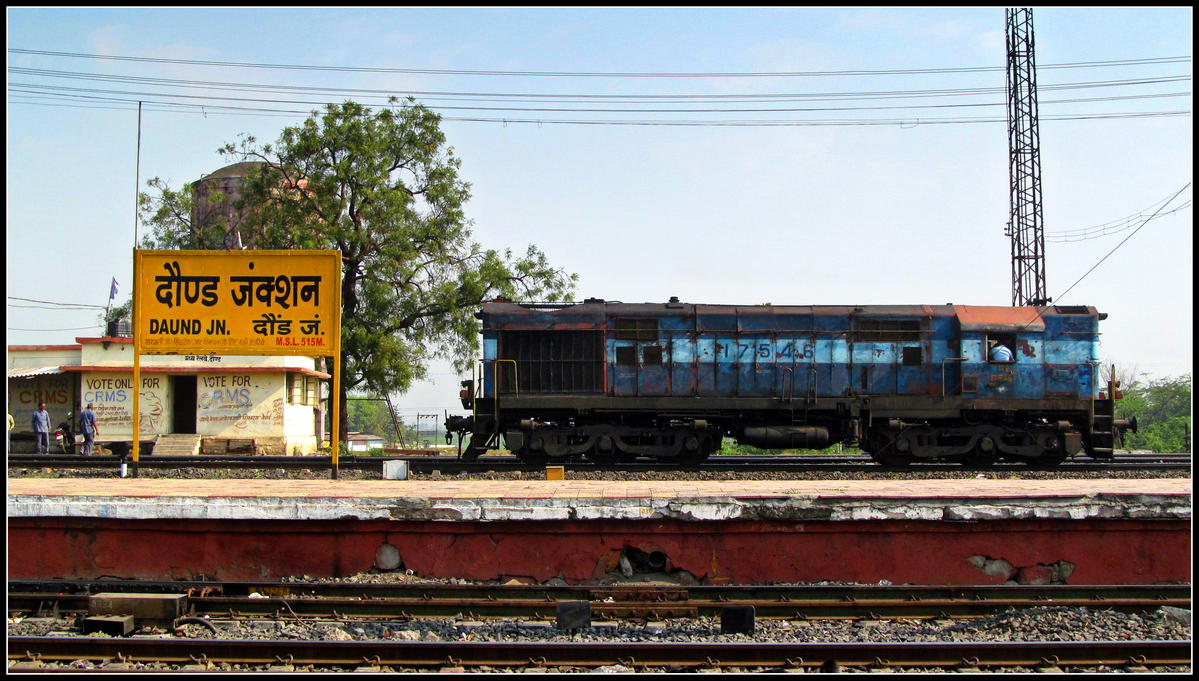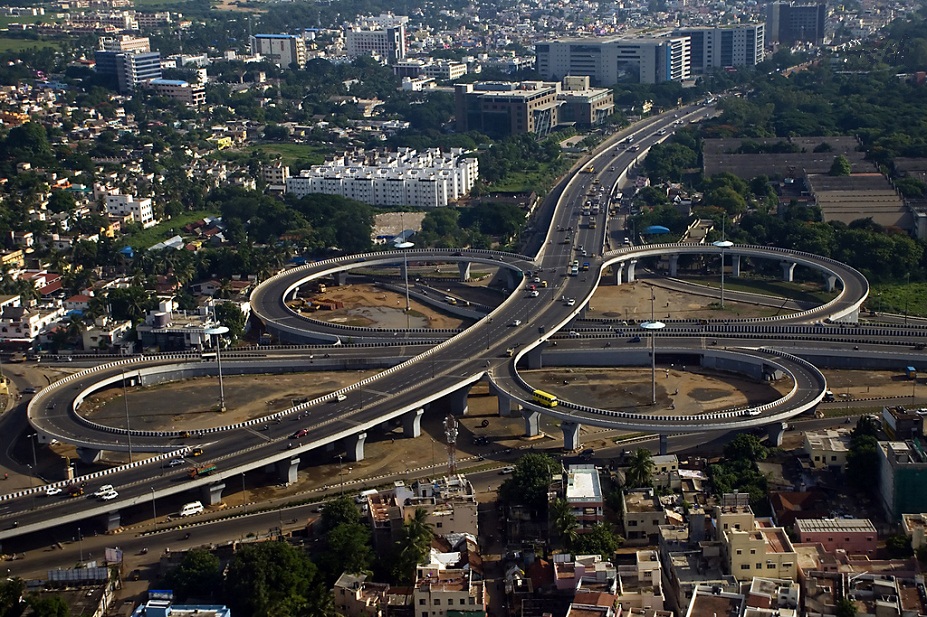|
Navjivan Express
The 12655 / 12656 Navjeevan Express is a Superfast Express train belonging to Southern Railways that runs between and . It is currently being operated with 12655/12656 train numbers on a daily basis. From November 2, 2019, it runs with highly refurbished LHB coach. It operates as train number 12655 from Ahmedabad Junction to Chennai Central and as train number 12656 in the reverse direction, serving the states of Gujarat, Maharashtra, Telangana, Andhra Pradesh and Tamil Nadu. History It was introduced in 1978 to run between Madras Beach and on a weekly basis. Originally numbered as 145/146, it departed Madras Beach at 06:00 on Tuesdays and arrived Ahmedabad Junction the next day at 17:30. On its return lap, it departed Ahmedabad Junction on Thursdays at 06:50, and reached Madras Beach the next evening at 19:50. The train ran via Renigunta––Daund––Jalgaon with a 24 coach haul, and a single WDM-2 diesel loco. A single coach AC 2 Sleeper accommodation was introdu ... [...More Info...] [...Related Items...] OR: [Wikipedia] [Google] [Baidu] |
Superfast Express Trains In India
India has a system of express trains, operated by Indian Railways which comes under the purview of the Ministry of Railways (India), Ministry of Railways of Government of India. , it maintains over of tracks, spanning across in route length, and operates nearly 3,000 express trains daily. According to the Ministry of Railways, express trains travel faster and have limited stops than Slow and fast passenger trains in India, ordinary passenger trains. Any passenger train with an average speed higher than is considered super-fast. , India does not have any operational High-speed railway, high-speed trains. The maximum operational speed of is achieved by Gatimaan Express and Rani Kamalapati (Habibganj)–Hazrat Nizamuddin Vande Bharat Express on the Tughlakabad railway station, TughlakabadAgra Cantonment railway station, Agra section. Earlier steam locomotive operated trains largely operated below . With the introduction of electric locomotives in later 1920s and newer steam ... [...More Info...] [...Related Items...] OR: [Wikipedia] [Google] [Baidu] |
Daund
Daund is a city, municipal council, and headquarters of the Daund tehsil in the Pune district in the state of Maharashtra, India. The city of Daund is located on the Bhima River. In ancient times, a sage named Dhaumya Rishi stayed here; hence, people started calling it after him: "Dhaum". Gradually "Dhaum" became "Dhoand", then "Dhaundh". According to the epic ''Mahabharata'', Krishna's wife Rukmini went in the "Dhindir forest"; this ancient "Dhindir Van" is today's Daund. History Maratha era Shahaji, father of Chhatrapati Shivaji Maharaj, was a sardar in the Nizam Shahi. He was granted Daund as a jagir, which included Bahadurgad, a fort in Pedgaon on the banks of the Bhima River (which still exists today). Peshwa era In 1739, the Bajirao– Mastani affair had brought clashes among the Peshwa family, hence Bajirao Peshwa took Mastani away from Pune and made her stay in Patas. Henceforth, Bajirao and Mastani met at the Firangai Devi temple in Kurkumbh. The horse busines ... [...More Info...] [...Related Items...] OR: [Wikipedia] [Google] [Baidu] |
1978 Establishments In India
Events January * January 1 – Air India Flight 855, a Boeing 747 passenger jet, crashes off the coast of Bombay, killing 213. * January 5 – Bülent Ecevit, of Republican People's Party, CHP, forms the new government of Turkey (42nd government). * January 6 – The Holy Crown of Hungary (also known as Stephen of Hungary Crown) is returned to Hungary from the United States, where it was held since World War II. * January 10 – Pedro Joaquín Chamorro Cardenal, a critic of the Nicaraguan government, is assassinated; riots erupt against Anastasio Somoza Debayle, Somoza's government. * January 13 – Former American Vice President Hubert Humphrey, a Democrat, dies of cancer in Waverly, Minnesota, at the age of 66. * January 18 – The European Court of Human Rights finds the British government guilty of mistreating prisoners in Northern Ireland, but not guilty of torture. * January 22 – Ethiopia declares the ambassador of West Germany ''persona non grata''. * January 24 ... [...More Info...] [...Related Items...] OR: [Wikipedia] [Google] [Baidu] |
Rail Transport In Tamil Nadu
Rail or rails may refer to: Rail transport *Rail transport and related matters *Railway track or railway lines, the running surface of a railway Arts and media Film * ''Rails'' (film), a 1929 Italian film by Mario Camerini * ''Rail'' (1967 film), a film by Geoffrey Jones for British Transport Films * ''Rail'' (2024 film), a Tamil-language film Magazines * ''Rail'' (magazine), a British rail transport periodical * ''Rails'' (magazine), a former New Zealand based rail transport periodical Other arts *The Rails, a British folk-rock band * Rail (theater) or batten, a pipe from which lighting, scenery, or curtains are hung Technology *Rails framework or Ruby on Rails, a web application framework *Rail system (firearms), a mounting system for firearm attachments *Front engine dragster *Runway alignment indicator lights, a configuration of an approach lighting system *Rule Augmented Interconnect Layout, a specification for expressing guidelines for printed circuit boards; companion ... [...More Info...] [...Related Items...] OR: [Wikipedia] [Google] [Baidu] |
Railway Services Introduced In 1978
Rail transport (also known as train transport) is a means of transport using wheeled vehicles running in tracks, which usually consist of two parallel steel rails. Rail transport is one of the two primary means of land transport, next to road transport. It is used for about 8% of passenger and freight transport globally, thanks to its energy efficiency and potentially high speed.Rolling stock on rails generally encounters lower frictional resistance than rubber-tyred road vehicles, allowing rail cars to be coupled into longer trains. Power is usually provided by diesel or electric locomotives. While railway transport is capital-intensive and less flexible than road transport, it can carry heavy loads of passengers and cargo with greater energy efficiency and safety. Precursors of railways driven by human or animal power have existed since antiquity, but modern rail transport began with the invention of the steam locomotive in the United Kingdom at the beginning of the 19th c ... [...More Info...] [...Related Items...] OR: [Wikipedia] [Google] [Baidu] |
Express Trains In India
India has a system of express trains, operated by Indian Railways which comes under the purview of the Ministry of Railways (India), Ministry of Railways of Government of India. , it maintains over of tracks, spanning across in route length, and operates nearly 3,000 express trains daily. According to the Ministry of Railways, express trains travel faster and have limited stops than Slow and fast passenger trains in India, ordinary passenger trains. Any passenger train with an average speed higher than is considered super-fast. , India does not have any operational High-speed railway, high-speed trains. The maximum operational speed of is achieved by Gatimaan Express and Rani Kamalapati (Habibganj)–Hazrat Nizamuddin Vande Bharat Express on the Tughlakabad railway station, TughlakabadAgra Cantonment railway station, Agra section. Earlier steam locomotive operated trains largely operated below . With the introduction of electric locomotives in later 1920s and newer steam ... [...More Info...] [...Related Items...] OR: [Wikipedia] [Google] [Baidu] |
Transport In Chennai
Transport in Chennai includes various modes of air, sea, road and rail transportation in the city and its suburbs. Chennai's economic development has been closely tied to its port and transport infrastructure, and it is considered one of the best infrastructure systems in India. History The city of Chennai is the birthplace of the railway system in India. In 1831–33, Madras Parliament first came up with the idea. In 1832, the first proposal of railway under the British administration was made in Madras, 21 years before the first operational railway line in India. Later in 1836 A. P. Cotton, a civil engineer in Madras, advocated the construction of a railroad in India. Meanwhile, in 1835, a short railway line intended to carry granite stones was laid at Chintadripet on an experimental basis, which later became to known as Red Hill Railroad line. Construction on this line began in 1836 and the line was opened in 1837. Despite a few troubles, the line became operational in the sa ... [...More Info...] [...Related Items...] OR: [Wikipedia] [Google] [Baidu] |
WAP-7
The Indian locomotive class WAP-7 is a class of 25 kV AC electric locomotives that was developed in 1999 by Chittaranjan Locomotive Works (CLW) for Indian Railways. The model name stands for broad gauge (W), AC Current (A), Passenger traffic (P) locomotive, 7th generation (7). They entered service in 2000. A total of 1909 WAP-7 have been built, with more units being built at CLW, Banaras Locomotive Works (BLW) and Patiala Locomotive Works (PLW). The WAP-7 has been serving passengers for Indian Railways since their introduction in 1999. It is a passenger variant of the WAG-9 freight locomotive with a modified gear ratio to pull lighter loads at higher speeds. With an output of 6,125 hp, it is the most powerful passenger locomotive in the Indian Railways fleet, and the most numerous passenger locomotive in India. The WAP-7 is capable of hauling 24 coach trains at speeds . It also capable of hauling 26 coaches trains at speeds of 130 km/h. History The WAP-7 is largely used b ... [...More Info...] [...Related Items...] OR: [Wikipedia] [Google] [Baidu] |
Electric Loco Shed, Erode
Electric Loco Shed, Erode is one of the premiere engine sheds located in Erode in the Indian state of Tamil Nadu. It is located along the Jolarpettai–Coimbatore line, about 1 km to the east of , under the administrative control of Salem railway division of Southern Railway zone. Locomotives Liveries Erode Loco Shed operates locomotives in various special liveries See also *Electric Loco Shed, Arakkonam * Electric Loco Shed, Royapuram * Diesel Loco Shed, Ernakulam * Diesel Loco Shed, Erode * Diesel Loco Shed, Golden Rock * Diesel Loco Shed, Tondiarpet References External links Website {{Locomotives Sheds of India Erode Erode (; īrōṭu), is a city in the Indian state of Tamil Nadu. It is located on the banks of the Kaveri river and is surrounded by the Western Ghats. Erode is the seventh largest urban agglomeration in Tamil Nadu. It is the administrativ ... Salem railway division Transport in Erode 1998 establishments in Tamil Nadu ... [...More Info...] [...Related Items...] OR: [Wikipedia] [Google] [Baidu] |
Electric Loco Shed, Royapuram
Electric Loco Shed, Royapuram is a motive power depot performing locomotive maintenance and repair facility for electric locomotives of the Indian Railways, located at Royapuram on the Chennai Beach– Katpadi section of the Chennai Suburban Railway network in Chennai, India. It is located in the Southern Railway zone and it is one of the three electric locomotive sheds of the Southern Railway, the others being at Erode (ED) and Arakkonam (AJJ) and is the newest in south India. History Steam locomotive sheds used to exist at Royapuram (RPM) and Basin Bridge (for Madras) until the late 1970s. After Southern Railway set a deadline to eliminate all steam locomotive operations by 1985, a push was given towards establishing electric locomotion as the primary motive power, and the Steam locomotive shed was decommissioned. To meet the needs of exponentially increasing rail traffic on the new continuous broad-gauge lines from Chennai to Kanyakumari and Palakkad with the completion of ... [...More Info...] [...Related Items...] OR: [Wikipedia] [Google] [Baidu] |
WDM-2
The Indian locomotive class WDM-2 is a class of diesel–electric locomotive that was developed in 1962 by American Locomotive Company (ALCO) for Indian Railways. The model name stands for 5 ft 6 in gauge railway, broad gauge (W), Diesel (D), Mixed traffic (M) engine, 2nd generation (2). They entered service in 1962. A total of more than 2,700 WDM-2 was built at ALCO and Banaras Locomotive Works (BLW or DLW, as it was formerly Diesel Locomotive Works), Varanasi between 1962 and 1998, which made them the most numerous class of mainline diesel locomotive until its successor the Indian locomotive class WDM-3A, WDM-3A. The WDM-2 is one of the most successful locomotives of Indian Railways serving both passenger and freight trains for over 60 years. A few WDM-2 units were exported to neighbouring countries like Sri Lanka Railways, Sri Lanka and Bangladesh Railway, Bangladesh. Despite the introduction of more modern types of locomotives like Indian locomotive class WDG-4, WDG-4 and e ... [...More Info...] [...Related Items...] OR: [Wikipedia] [Google] [Baidu] |









